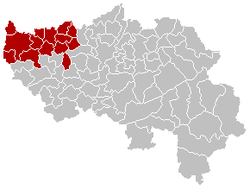Arrondissement of Waremme
|
Arrondissement of Waremme Arrondissement de Waremme |
|
|---|---|
| Arrondissement | |

Waremme Railway Station
|
|
 Location of the arrondissement in Liège |
|
| Coordinates: 50°39′N 5°12′E / 50.65°N 5.2°ECoordinates: 50°39′N 5°12′E / 50.65°N 5.2°E | |
| Country |
|
| Region |
|
| Province |
|
| Municipalities | 14 |
| Area | |
| • Total | 389.86 km2 (150.53 sq mi) |
| Population (1 January 2015) | |
| • Total | 78,851 |
| • Density | 200/km2 (520/sq mi) |
| Time zone | CET (UTC+1) |
| • Summer (DST) | CEST (UTC+2) |
The Arrondissement of Waremme (French: Arrondissement de Waremme; Dutch: Arrondissement Borgworm) is one of the four administrative arrondissements in the Province of Liège, Belgium. Its size is 389.86 km2 (150.53 sq mi) and its population on 1 January 2015 was 78,851 people.
The Arrondissement is only an administrative one. Judicially its communes depend on the Arrondissement of Liège except for Braives, Hannut, Lincent, Saint-Georges-sur-Meuse, and Wasseiges who depend on Huy.
The Waremme administrative district was created in 1821 by joining the cantons of Avennes and Landen (taken from Huy) and the canton of Waremme (taken from Liège).
During the final fixing of the linguistic border in 1963 the communes of Attenhoven, Eliksem, Laar, Landen, Neerhespen, Neerlanden, Neerwinden, Overhespen, Overwinden, Rumsdorp, Wamont, Walsbets, Houtain-l'Évêque, Wange, and Wezeren were assigned to the Arrondissement of Leuven. The commune of Corswarem and part of Montenaken were assigned to the Arrondissement of Hasselt and the commune of Otrange to the Arrondissement of Tongeren.
...
Wikipedia
